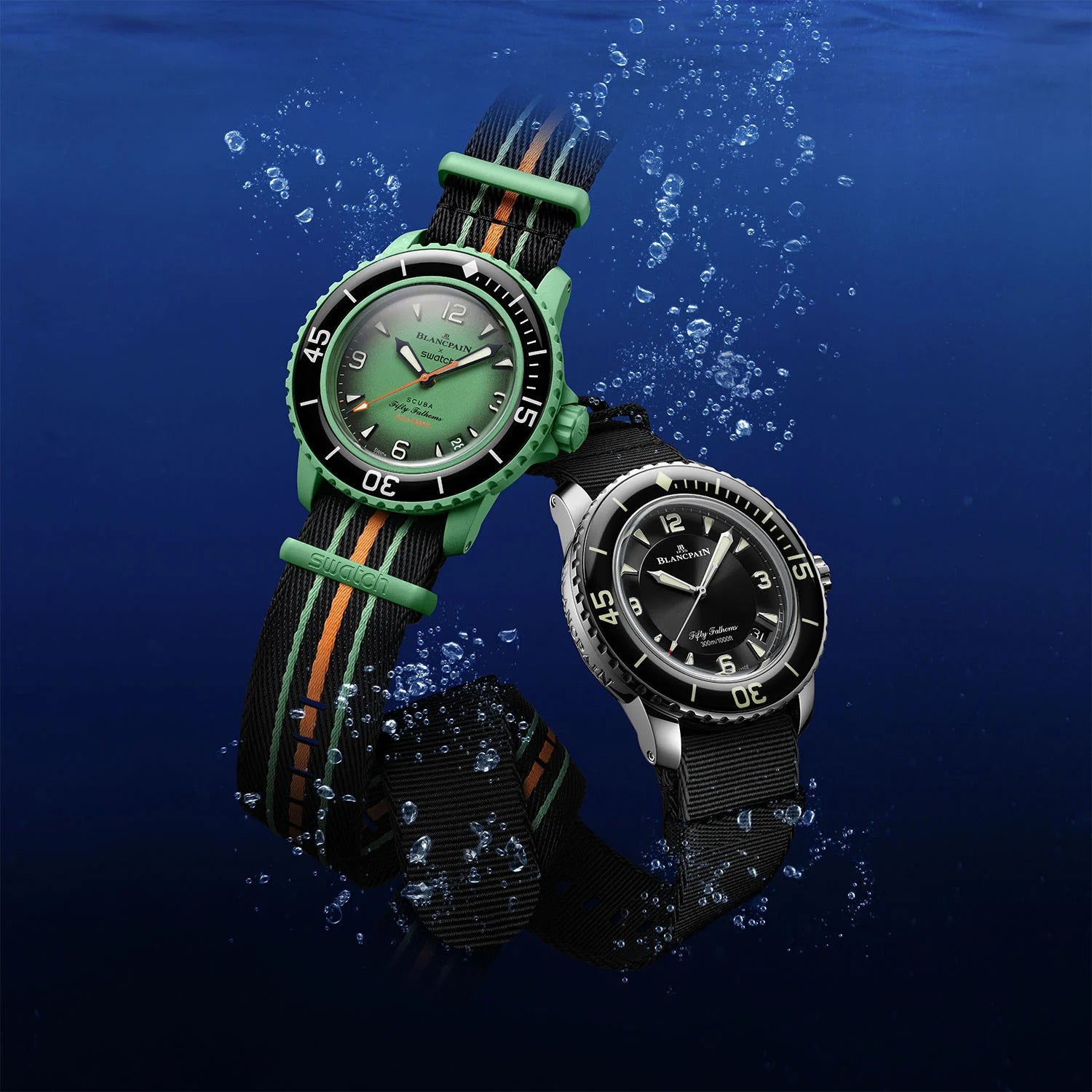
Introducing the Swatch x Blancpain Scuba: Swatch's Latest Bioceramic Collab With The Blancpain Fifty Fathoms
Just over eighteen months after Swatch announced their industry-shifting collaboration with fellow Swatch Group brand Omega and a week's worth of hype, the Swiss watchmaking giant has announced, to much fanfare, their latest intra-group collab between Swatch and Blancpain – the world's oldest watchmaker. Inspired by Blancpain's iconic diver from 1953, the Fifty-Fathoms (just like how the Omega x Swatch collab was inspired by the Speedmaster), this latest collab reimagines the 70-year-old dive watch as a new colourful bio-ceramic Swatch creation, the "Scuba".

Offered as a collection of five different timepieces and retailing for €390, the so-called Scuba takes its aesthetic inspiration from the five seas themselves with a selection of different bio-ceramic case colours ranging from orange-gold to green, blue to beige and even ice-white that are then paired with a variety of different coloured dials. Measuring 42.3mm in diameter with a 14.4mm thickness and 48mm from lug-to-lug, the Scuba wears with the exact proportions as the Fifty-Fathoms itself but with the lightness of a bio-ceramic Swatch.

Split into two groups, the five models all retain identical gradient finishes on their dials, but with two slightly different dial layouts to choose from, both of which are inspired by Fifty-Fathoms models. Starting with the date version, three of the five watches feature Arabic numerals at 3, 6, 9 and 12 o'clock, applied triangular indices elsewhere and a date aperture at 4:30. The two other models are no-date versions that have different applied indices and feature tributes to rare editions of the Blancpain Fifty-Fathoms at 6 o'clock on the dials. These are the "No-Rad" logo that would originally tell the wearer their watch did not feature radium in its dial, and a moisture indicator that would tell the wearer that their watch had been compromised and water had entered the watch, known as a "Mil-Spec" logo, as it was a specification set by militaries that ordered the Fifty-Fathoms for their divers.

Inspired by the five seas, as mentioned, the five versions are as follows:

Pacific Ocean
Featuring an orange-gold Bioceramic case, black bezel, white to black gradient finish dial, date display at 4:30 and a black and orange NATO strap.
Atlantic Ocean
Featuring a blue Bioceramic case, blue bezel, blue to navy gradient finish dial, date display at 4:30 and a blue NATO strap.
Indian Ocean
Featuring a green Bioceramic case, black bezel, green gradient finish dial, date display at 4:30 and a black and a green NATO strap.
Arctic Ocean
Featuring a beige Bioceramic case, an orange bezel, a beige gradient finish dial, a "No-Radiations" logo at 6 o'clock, no date display and an orange NATO strap.
Antarctic Ocean
Featuring an ice white Bioceramic case, a grey bezel, a grey gradient finish dial, a Mil-Spec moisture indicator at 6 o'clock, no date display and a grey and blue NATO strap.

Beyond just how they look and what they are inspired by, the Scuba carries on a Blancpain tradition that people feared might have been broken by this release when Swatch first teased it. As famously said by Jean-Claude Biver, Blancpain has never, and will never, produce a quartz watch. In keeping with that statement, the Scuba is not quartz-powered like its MoonSwatch sibling. Instead, it is automatic thanks to Swatch's Sistem51 automatic movement. Featuring just 51 parts, the Sistem51 boasts a genuinely exceptional 90-hour power reserve and an accuracy of -5/+15 seconds per day, which isn't too bad at all.

However, to give the Scuba its 91 meters of water resistance, which is exactly 50 Fathoms (what the Fifty-Fathoms is named after as it was its original depth rating in 1953), its caseback is glued shut, which means the Scuba is not a watch that can be repaired at all. If the Sistem51 movement breaks, the watch must be entirely replaced.

Additionally, in a rather ironic twist, the Sistem51 is also somewhat unreliable out of the box due to its plastic parts and single-screw construction. So, the chance of the watch not working soon after it is bought and requiring a replacement is higher than it would have been if Swatch used one of their quartz movements instead. On the other side of the argument, Swatch could have instead used this release as an opportunity to create a more reliable version of the Sistem51 with metal parts or a completely new, even more reliable movement. While the Sistem51 is a technological masterpiece from some viewpoints, it is also this collection's glaring weakness that, for €390, could have been avoided. Nonetheless, these watches will undoubtedly fly off the shelves and create hysteria, just like the MoonSwatch did all those months ago.

So, with success basically guaranteed for this launch, what intra-group collab is next for Swatch? Will Swatch make their way through all of the Swatch Group's brands and launch Bioceramic versions of their most iconic models? If so, will we see a Bioceramic Swatch x Breguet Type 20, a Bioceramic Swatch x Hamilton Khaki Field, or a Swatch x Omega Seamaster? Only time will tell, but it's pretty confident that this isn't the last we'll see of Swatch and their Bioceramic-fuelled collaborations with their fellow Swatch Group brands, at least until the trick gets old and people stop buying them, which is probably a long way away.
For more information straight from the source, visit Swatch here.


Leave a comment
This site is protected by hCaptcha and the hCaptcha Privacy Policy and Terms of Service apply.